Tamarind
Tamarind (Tamarindus indica) is a leguminous tree (family Fabaceae) bearing edible fruit that is indigenous to tropical Africa. The genus Tamarindus is monotypic, meaning that it contains only this species.
| Tamarind | |
|---|---|
| Scientific classification | |
| Kingdom: | |
| (unranked): | |
| (unranked): | |
| (unranked): | |
| Order: | |
| Family: | |
| Subfamily: | |
| Genus: | Tamarindus |
| Species: | T. indica |
| Binomial name | |
| Tamarindus indica L. 1753 | |
| Synonyms[2][3][4] | |
| |
The tamarind tree produces brown, pod-like fruits that contain a sweet, tangy pulp, which is used in cuisines around the world. The pulp is also used in traditional medicine and as a metal polish. The tree's wood can be used for woodworking and tamarind seed oil can be extracted from the seeds. Tamarind's tender young leaves are used in Indian cuisine.[6] Because tamarind has multiple uses, it is cultivated around the world in tropical and subtropical zones.
Etymology
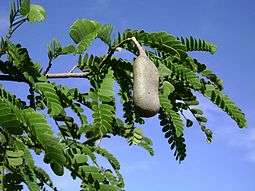
The name derives from Arabic: تمر هندي, romanized tamar hindi, "Indian date". Several early medieval herbalists and physicians wrote tamar indi, medieval Latin use was tamarindus, and Marco Polo wrote of tamarandi.[7]
In Colombia, Ecuador, Cuba, Dominican Republic, Guatemala, El Salvador, Honduras, Mexico, Peru, Puerto Rico, Venezuela, Italy, Spain, and throughout the Lusosphere, it is called tamarindo. In those countries it is often used to make the beverage of the same name (or agua de tamarindo). In East Timor it is also called sukaer. In the Caribbean, tamarind is sometimes called tamón.[8] In the Philippines, it is called sampalok or sampaloc in Filipino, and sambag in Cebuano.[9] Tamarind (Tamarindus indica) is sometimes confused with "Manila tamarind" (Pithecellobium dulce). While in the same taxonomic family Fabaceae, Manila tamarind is a different plant native to Mexico and known locally as guamúchili.
Origin
Tamarindus indica is probably indigenous to tropical Africa,[10] but has been cultivated for so long on the Indian subcontinent that it is sometimes reported to be indigenous there.[8] It grows wild in Africa in locales as diverse as Sudan, Cameroon, Nigeria, Kenya, Zambia, Somalia and Tanzania. In Arabia, it is found growing wild in Oman, especially Dhofar, where it grows on the sea-facing slopes of mountains. It reached South Asia likely through human transportation and cultivation several thousand years ago.[8][11] It is widely distributed throughout the tropics, from Africa to South Asia, northern Australia, and throughout Oceania, Southeast Asia, Taiwan and China.
In the 16th century, it was introduced to Mexico and Central America, and to a lesser degree to South America, by Spanish and Portuguese colonists, to the degree that it became a staple ingredient in the region's cuisine.[12]
Today, India is the largest producer of tamarind.[13] The consumption of tamarind is widespread due to its central role in the cuisines of the Indian subcontinent, Southeast Asia, and the Americas, especially Mexico.
Description
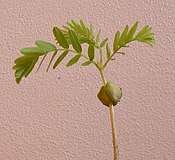
The tamarind is a long-lived, medium-growth tree, which attains a maximum crown height of 12 to 18 metres (40 to 60 feet). The crown has an irregular, vase-shaped outline of dense foliage. The tree grows well in full sun. It prefers clay, loam, sandy, and acidic soil types, with a high resistance to drought and aerosol salt (wind-borne salt as found in coastal areas).[14]
The evergreen leaves are alternately arranged and pinnately lobed. The leaflets are bright green, elliptic-ovular, pinnately veined, and less than 5 cm (2 in) in length. The branches droop from a single, central trunk as the tree matures, and are often pruned in agriculture to optimize tree density and ease of fruit harvest. At night, the leaflets close up.[14]
As a tropical species, it is frost-sensitive. The pinnate leaves with opposite leaflets give a billowing effect in the wind. Tamarind timber consists of hard, dark red heartwood and softer, yellowish sapwood.[15]
The tamarind flowers (although inconspicuously), with red and yellow elongated flowers. Flowers are 2.5 cm wide (one inch), five-petalled, borne in small racemes, and yellow with orange or red streaks. Buds are pink as the four sepals are pink and are lost when the flower blooms.[16]

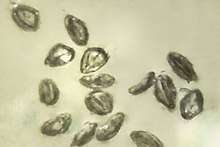
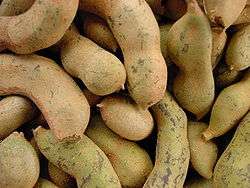
Fruit
The fruit is an indehiscent legume, sometimes called a pod, 12 to 15 cm (4 1⁄2 to 6 in) in length, with a hard, brown shell.[17][18][19]
The fruit has a fleshy, juicy, acidic pulp. It is mature when the flesh is coloured brown or reddish brown. The tamarinds of Asia have longer pods (containing six to 12 seeds), whereas African and West Indian varieties have shorter pods (containing one to six seeds). The seeds are somewhat flattened, and a glossy brown. The fruit is best described as sweet and sour in taste, and is high in tartaric acid, sugar, B vitamins, and, unusually for a fruit, calcium.[14]
The fruit is harvested by pulling the pod from its stalk. A mature tree may be capable of producing up to 175 kg (386 lb) of fruit per year. Veneer grafting, shield (T or inverted T) budding, and air layering may be used to propagate desirable cultivars. Such trees will usually fruit within three to four years if provided optimum growing conditions.[14]
Culinary use
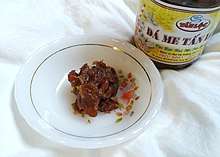
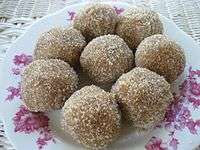
| Nutritional value per 100 g (3.5 oz) | |
|---|---|
| Energy | 239 kcal (1,000 kJ) |
62.5 g | |
| Sugars | 57.4 |
| Dietary fiber | 5.1 g |
0.6 g | |
| Saturated | 0.272 g |
| Monounsaturated | 0.181 g |
| Polyunsaturated | 0.059 g |
2.8 g | |
| Tryptophan | 0.018 g |
| Lysine | 0.139 g |
| Methionine | 0.014 g |
| Vitamins | Quantity %DV† |
| Vitamin A equiv. | 0% 2 μg |
| Vitamin A | 30 IU |
| Thiamine (B1) | 37% 0.428 mg |
| Riboflavin (B2) | 13% 0.152 mg |
| Niacin (B3) | 13% 1.938 mg |
| Pantothenic acid (B5) | 3% 0.143 mg |
| Vitamin B6 | 5% 0.066 mg |
| Folate (B9) | 4% 14 μg |
| Choline | 2% 8.6 mg |
| Vitamin C | 4% 3.5 mg |
| Vitamin E | 1% 0.1 mg |
| Vitamin K | 3% 2.8 μg |
| Minerals | Quantity %DV† |
| Calcium | 7% 74 mg |
| Copper | 43% 0.86 mg |
| Iron | 22% 2.8 mg |
| Magnesium | 26% 92 mg |
| Phosphorus | 16% 113 mg |
| Potassium | 13% 628 mg |
| Selenium | 2% 1.3 μg |
| Sodium | 2% 28 mg |
| Zinc | 1% 0.1 mg |
| Other constituents | Quantity |
| Water | 31.40 g |
USDA Database; entry | |
| |
| †Percentages are roughly approximated using US recommendations for adults. Source: USDA Nutrient Database | |
The fruit pulp is edible. The hard green pulp of a young fruit is considered by many to be too sour, but is often used as a component of savory dishes, as a pickling agent or as a means of making certain poisonous yams in Ghana safe for human consumption.[20] As the fruit matures it becomes sweeter and less sour (acidic) and the ripened fruit is considered more palatable. The sourness varies between cultivars and some sweet tamarind ones have almost no acidity when ripe. In Western cuisine, tamarind pulp is found in Worcestershire Sauce[21] and HP Sauce.
Tamarind paste has many culinary uses including a flavoring for chutnies, curries, and the traditional sharbat syrup drink.[22] Tamarind sweet chutney is popular in India and Pakistan[23] as a dressing for many snacks. Tamarind pulp is a key ingredient in flavoring curries and rice in south Indian cuisine, in the Chigali lollipop, and in certain varieties of Masala Chai tea. Across the Middle East, from the Levant to Iran, tamarind is used in savory dishes, notably meat-based stews, and often combined with dried fruits to achieve a sweet-sour tang.[24][25] In the Philippines, the whole fruit is used as an ingredient in the traditional dish called sinigang to add a unique sour taste, unlike that of dishes that use vinegar instead. Indonesia also has a similarly sour, tamarind-based soup dish called sayur asem.
In Mexico and the Caribbean, the pulp is diluted with water and sugared to make an agua fresca drink.
Tamarind seed oil
Tamarind seed oil is the oil made from the kernel of tamarind seeds.[26] Isolation of the kernel without the thin but tough shell (or testa) is difficult. Tamarind kernel powder is used as sizing material for textile and jute processing, and in the manufacture of industrial gums and adhesives. It is de-oiled to stabilize its colour and odor on storage.
Composition of tamarind seed kernel
| Composition | Original | De-oiled |
| Oil | 7.6% | 0.6% |
| Protein | 7.6% | 19.0% |
| Polysaccharide | 51.0% | 55.0% |
| Crude fiber | 1.2% | 1.1% |
| Total ash | 3.9% | 3.4% |
| Acid insoluble ash | 0.4% | 0.3% |
| Moisture | 7.1% |
The fatty acid composition of the oil is linoleic 46.5%, oleic 27.2%,
and saturated fatty acids 26.4%. The oil is usually bleached after refining.
Fatty acid composition of tamarind kernel oil
| Fatty acid | (%) Range reported |
| Lauric acid (C12:0) | tr-0.3 |
| Myristic acid (C14:0) | tr-0.4 |
| Palmitic acid (C16:0) | 8.7–14.8 |
| Stearic acid (C18:0) | 4.4–6.6 |
| Arachidic acid (C20:0) | 3.7–12.2 |
| Lignoceric acid (C24:0) | 4.0–22.3 |
| Oleic acid (C18:1) | 19.6–27.0 |
| Linoleic acid (18:2) | 7.5–55.4 |
| Linolenic acid (C18:3) | 2.8–5.6 |
Cultivation

Seeds can be scarified or briefly boiled to enhance germination. They retain their germination capability for several months if kept dry.
The tamarind has long been naturalized in Indonesia, Malaysia, Sri Lanka, the Philippines, the Caribbean, and Pacific Islands. Thailand has the largest plantations of the ASEAN nations, followed by Indonesia, Myanmar, and the Philippines. In parts of Southeast Asia, tamarind is called asam.[27] It is cultivated all over India, especially in Maharashtra, Chhattisgarh, Karnataka, Telangana, Andhra Pradesh, and Tamil Nadu. Extensive tamarind orchards in India produce 275,500 tons (250,000 MT) annually.[14]

In the United States, it is a large-scale crop introduced for commercial use (second in net production quantity only to India), mainly in southern states, notably south Florida, and as a shade tree, along roadsides, in dooryards and in parks.[28]
A traditional food plant in Africa, tamarind has the potential to improve nutrition, boost food security, foster rural development and support sustainable landcare.[29] In Madagascar, its fruit and leaves are a well-known favorite of the ring-tailed lemur, providing as much as 50 percent of their food resources during the year if available.[30]
Folk medicine
Throughout Southeast Asia, the fruit of the tamarind is used as a poultice applied to foreheads of fever sufferers.[17] The fruit exhibits laxative effects due to its high quantities of malic acid, tartaric acid, and potassium bitartrate. Its use for the relief of constipation has been documented throughout the world.[31][32]
Woodworking
Tamarind lumber is used to make furniture, carvings, turned objects such as mortars and pestles, chopping blocks, and other small specialty wood items. Tamarind heartwood is reddish brown, sometimes with a purplish hue. The heartwood in tamarind tends to be narrow and is usually only present in older and larger trees. The pale yellow sapwood is sharply demarcated from the heartwood. Heartwood is said to be durable to very durable in decay resistance, and is also resistant to insects. Its sapwood is not durable and is prone to attack by insects and fungi as well as spalting. Due to its density and interlocked grain, tamarind is considered difficult to work. Heartwood has a pronounced blunting effect on cutting edges. Tamarind turns, glues, and finishes well. The heartwood is able to take a high natural polish.[33]
Metal polish
In homes and temples, especially in Buddhist Asian countries, the fruit pulp is used to polish brass shrine statues and lamps, and copper, brass, and bronze utensils. The copper alone or in brass reacts with moist carbon dioxide to gain a green coat of copper carbonate. Tamarind contains tartaric acid, a weak acid that can remove the coat of copper carbonate. Hence, tarnished copper utensils are cleaned with tamarind or lime, another acidic fruit.[8]
Horticulture
Throughout South Asia and the tropical world, tamarind trees are used as ornamental, garden, and cash crop plantings. Commonly used as a bonsai species in many Asian countries, it is also grown as an indoor bonsai in temperate parts of the world.[34]
Research
In hens, tamarind has been found to lower cholesterol in their serum, and in the yolks of the eggs they laid.[35][36] Due to a lack of available human clinical trials, there is insufficient evidence to recommend tamarind for the treatment of hypercholesterolemia or diabetes.[37] Different parts of tamarind (T. indica) are recognized for their various medicinal properties. A previous study reported that the seed, leaf, leaf veins, fruit pulp and skin extracts of tamarind possessed high phenolic content and antioxidant activities.[38] The presence of lupanone and lupeol,[39] catechin, epicatechin, quercetin and isorhamnetin[38] in the leaf extract could have contributed towards the diverse range of the medicinal activities. On the other hand, ultra-high performance liquid chromatography (UHPLC) analyses revealed that tamarind seeds contained catechin, procyanidin B2, caffeic acid, ferulic acid, chloramphenicol, myricetin, morin, quercetin, apigenin and kaempferol.[40] The treatment of tamarind leaves on liver HepG2 cells significantly regulated the expression of genes and proteins involved with consequential impact on the coagulation system, cholesterol biosynthesis, xenobiotic metabolism signaling and antimicrobial response.[41]
See also
- Historical tamarind
References
- Rivers, M.C. & Mark, J. (2017). "Tamarindus indica". IUCN Red List of Threatened Species. 2017: e.T62020997A62020999. Retrieved May 1, 2020.
- "Tamarindus indica L." The Plant List. Royal Botanic Gardens, Kew and the Missouri Botanical Garden. 2013. Retrieved February 28, 2017.
- Quattrocchi U. (2012). CRC World Dictionary of Medicinal and Poisonous Plants: Common Names, Scientific Names, Eponyms, Synonyms, and Etymology. Boca Raton, Louisiana: CRC Press, Taylor & Francis Group. pp. 3667–3668. ISBN 9781420080445.
- USDA; ARS; National Genetic Resources Program (February 10, 2005). "Cavaraea Speg". Germplasm Resources Information Network—(GRIN) [Online Database]. National Germplasm Resources Laboratory, Beltsville, Maryland. Retrieved February 28, 2017.
- Speg. Anales Soc. Ci. Argent. 82: 223 1916
- Borah, Prabalika M. (April 27, 2018). "Here's what you can cook with tender tamarind leaves". The Hindu.
- Tamarind; Oxford English dictionary
- Morton, Julia F. (1987). Fruits of Warm Climates. Wipf and Stock Publishers. pp. 115–121. ISBN 978-0-9653360-7-9.
- Polistico, Edgie (2017). Philippine Food, Cooking, & Dining Dictionary. Anvil Publishing, Inc. ISBN 9786214200870.
- Diallo, BO; Joly, HI; McKey, D; Hosaert-McKey, M; Chevallier, MH (2007). "Genetic diversity of Tamarindus indica populations: Any clues on the origin from its current distribution?". African Journal of Biotechnology. 6 (7).
- Popenoe, W. (1974). Manual of Tropical and Subtropical Fruits. Hafner Press. pp. 432–436.
- Tamale, E.; Jones, N.; Pswarayi-Riddihough, I. (August 1995). Technologies Related to Participatory Forestry in Tropical and Subtropical Countries. World Bank Publications. ISBN 978-0-8213-3399-0.
- Tamarind monograph; PDF format; retrieved May 2017
- "Tamarind – Tamarindus indica – van Veen Organics". van Veen Organics. Retrieved June 4, 2017.
- "Tamarind: a multipurpose tree". DAWN.COM. July 9, 2007. Retrieved June 4, 2017.
- "Tamarind". Plant Lexica. Retrieved June 4, 2017.
- Doughari, J. H. (December 2006). "Antimicrobial Activity of Tamarindus indica". Tropical Journal of Pharmaceutical Research. 5 (2): 597–603. doi:10.4314/tjpr.v5i2.14637.
- "Fact Sheet: Tamarindus indica" (PDF). University of Florida. Retrieved July 22, 2012.
- Christman, S. "Tamarindus indica". FloriData. Retrieved January 11, 2010.
- El-Siddig, K. (2006). Tamarind: Tamarindus indica L. ISBN 9780854328598.
- "BBC Food:Ingredients—Tamarind recipes". BBC. Retrieved February 23, 2015.
- Azad, Salim (2018). "Tamarindo—Tamarindus indica". In Sueli Rodrigues; Ebenezer de Oliveira Silva; Edy Sousa de Brito (eds.). Exotic Fruits. Academic Press. pp. 403–412. doi:10.1016/B978-0-12-803138-4.00055-1. ISBN 978-0-12-803138-4.
- The Complete Asian Cookbook. Tuttle Publishing. 2006. p. 88. ISBN 9780804837576.
- "Tamarind is the 'sour secret of Syrian cooking'". PRI. July 2014
- Nathan, Joan (2004). "Georgian Chicken in Pomegranate and Tamarind Sauce". New York Times
- Tamarind Seeds. agriculturalproductsindia.com
- "Asam or Tamarind tree (Tamarindus indica) on the Shores of Singapore". www.wildsingapore.com. Retrieved April 14, 2018.
- "Food and Agriculture Organization of the United Nations".
- National Research Council (January 25, 2008). "Tamarind". Lost Crops of Africa: Volume III: Fruits. Lost Crops of Africa. 3. National Academies Press. doi:10.17226/11879. ISBN 978-0-309-10596-5. Retrieved July 17, 2008.
- "Ring-Tailed Lemur". Wisconsin Primate Research Center. Retrieved November 14, 2016.
- Havinga, Reinout M.; Hartl, Anna; Putscher, Johanna; Prehsler, Sarah; Buchmann, Christine; Vogl, Christian R. (February 2010). "Tamarindus Indica L. (Fabaceae): Patterns of Use in Traditional African Medicine". Journal of Ethnopharmacology. 127 (3): 573–588. doi:10.1016/j.jep.2009.11.028. PMID 19963055.
- Panthong, A; Khonsung, P; Kunanusorn, P; Wongcome, T; Pongsamart, S (July 2008). "The laxative effect of fresh pulp aqueous extracts of Thai Tamarind cultivars". Planta Medica. 74 (9). doi:10.1055/s-0028-1084885.
- "Tamarind". The Wood Database. Retrieved December 22, 2016.
- D'Cruz, Mark. "Ma-Ke Bonsai Care Guide for Tamarindus indica". Ma-Ke Bonsai. Retrieved August 19, 2011.
- Salma, U.; Miah, A. G.; Tareq, K. M. A.; Maki, T.; Tsujii, H. (April 1, 2007). "Effect of Dietary Rhodobacter capsulatus on Egg-Yolk Cholesterol and Laying Hen Performance". Poultry Science. 86 (4): 714–719. doi:10.1093/ps/86.4.714. PMID 17369543.
as well as in egg-yolk (13 and 16%)
- Chowdhury, SR; Sarker, DK; Chowdhury, SD; Smith, TK; Roy, PK; Wahid, MA (2005). "Effects of dietary tamarind on cholesterol metabolism in laying hens". Poultry Science. 84 (1): 56–60. doi:10.1093/ps/84.1.56. PMID 15685942.
- "Tamarindus indica". Health Online. Retrieved January 11, 2010.
- Razali, Nurhanani; Mat-Junit, Sarni; Abdul-Muthalib, Amirah Faizah; Subramaniam, Senthilkumar; Abdul-Aziz, Azlina (2012). "Effect of various solvents on the extraction of antioxidant phenolics from the leaves, seeds, veins and skins of Tamarindus indica L.". Food Chemistry. 131 (2): 441–448. doi:10.1016/j.foodchem.2011.09.001.
- Imam, S.; Azhar, I.; Hasan, M. M.; Ali, M. S.; Ahmed, S. W. (2007). "Two triterpenes lupanone and lupeol isolated and identified from Tamarindus indica linn". Pakistan Journal of Pharmaceutical Sciences. 20 (2): 125–7. PMID 17416567.
- Razali, N.; Mat Junit, S.; Ariffin, A.; Ramli, N. S.; Abdul Aziz, A. (2015). "Polyphenols from the extract and fraction of T. indica seeds protected HepG2 cells against oxidative stress". BMC Complementary and Alternative Medicine. 15: 438. doi:10.1186/s12906-015-0963-2. PMC 4683930. PMID 26683054.
- Razali, Nurhanani; Abdul Aziz, Azlina; Lim, Chor Yin; Mat Junit, Sarni (2015). "Investigation into the effects of antioxidant-rich extract of Tamarindus indicaleaf on antioxidant enzyme activities, oxidative stress and gene expression profiles in HepG2 cells". PeerJ. 3: e1292. doi:10.7717/peerj.1292. PMC 4636403. PMID 26557426.
External links
| Wikimedia Commons has media related to Tamarindus indica. |
- SEA Hand Book-2009: Published by The Solvent Extractors' Association of India
- Tamarindus indica in Brunken, U., Schmidt, M., Dressler, S., Janssen, T., Thiombiano, A. & Zizka, G. 2008. West African plants – A Photo Guide.
- . Encyclopædia Britannica (11th ed.). 1911.

